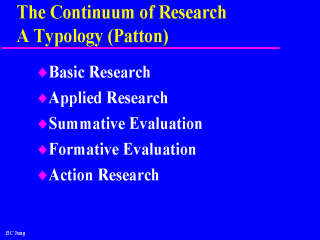| front |1 |2 |3 |4 |5 |6 |7 |8 |9 |10 |11 |12 |13 |14 |15 |16 |17 |18 |19 |20 |21 |22 |23 |24 |25 |26 |27 |28 |29 |30 |review |
 |
Patton’s
typology offers a useful scheme for looking at the various types of research that can be
performed. Most of what we consider “Research” in the generic sense is Basic Research,
which I will go into more detail in a little bit. This scheme does explain the different approaches researchers can take in studying phenomena, and actually helps to explain the various research and evaluative studies conducted in Public Health. In fact, if you view Public Health as an applied science, then you can see why conducting basic research may not always be the best approach to studying phenomena in the field of Public Health. Certainly, the world is not a laboratory, and there are limits to human experimentation. You can probably say epidemiologists are astute observers of phenomena, and their systematic observations are the basis of such public health research as observational studies. So, I find Patton’s scheme to be useful in capturing the various studies that can be conducted to deal with a specific public health problem. This typology is organized from the most rigorous to the least rigorous. This is not to say action research is less valuable than basic research, only that it may not be as formal, or structured as basic research, and its findings may not be generalizable beyond the study itself as basic research strives to be. I would think that all Public Health Practitioners can conduct action research in their work, and probably should. |